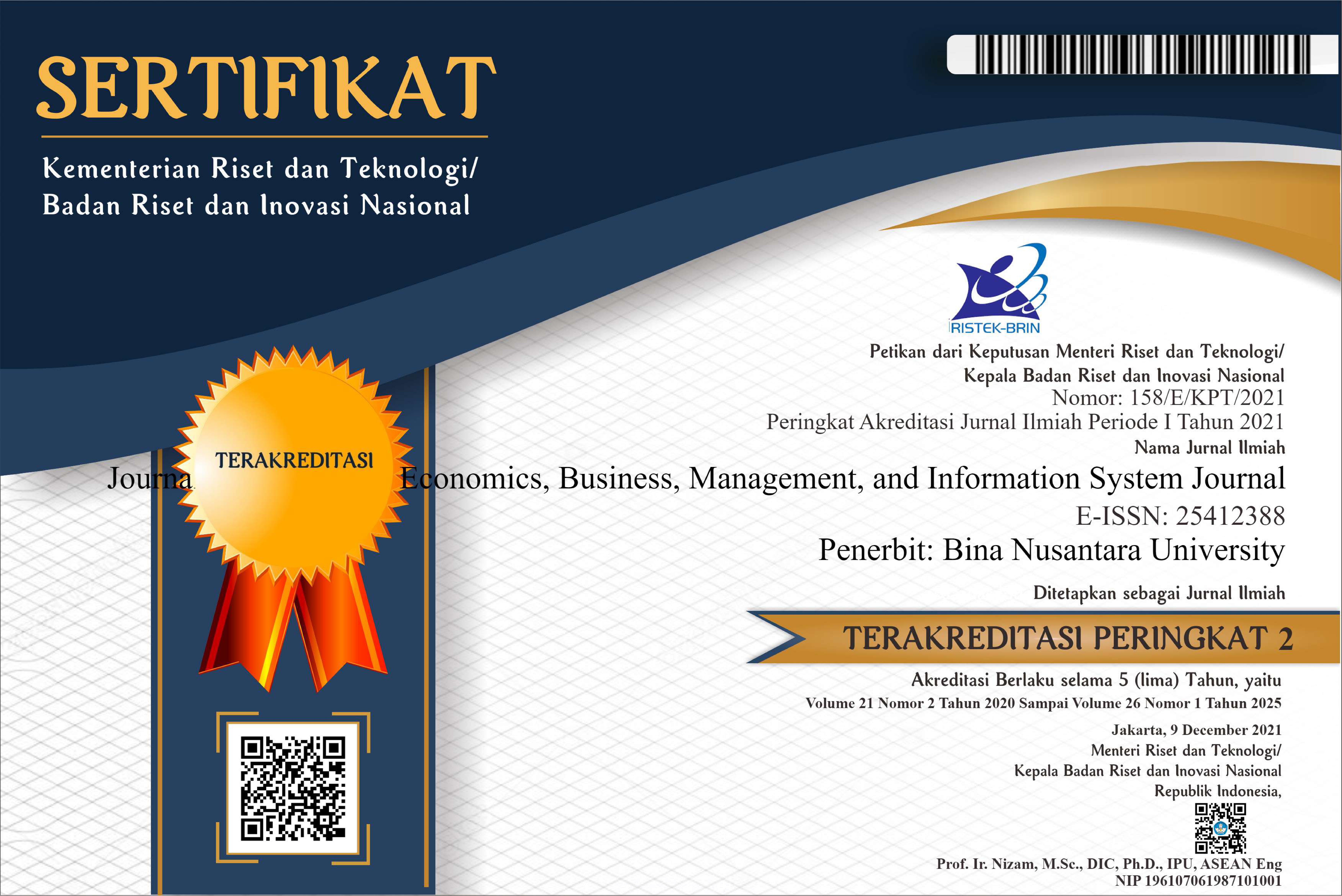The Role of Oil Palm and Rubber Industry toward Regional Economic in West Kalimantan-Indonesia
DOI:
https://doi.org/10.21512/tw.v18i2.4116Keywords:
economic, industry, oil palm, rubberAbstract
The study aimed to assess the role of palm oil and rubber toward the economy in West Kalimantan. Another aim was to develop oil palm and rubber industry to strengthen the economy of West Kalimantan. The method used in this research was the analysis of Input-Output. The main data was the Input-Output (IO) data in 2011 from the Central Bureau of Statistics (BPS), which consists of 54 sectors. The results show that the industrial output of palm oil and rubber, as well as oil palm and rubber, is still low. Weak innovation and technology lead to the low output and role of these two sectors to the economy of West Kalimantan. Another obstacle that leads to the economy of rubber and palm oil industries under the standard is the lack of motivation research, infrastructure, and connectivity.
Plum Analytics
References
Amzul, R. (2011). The role of palm oil industry in Indonesian economy and its export competitiveness. Japan: University of Tokyo.
Arman, Hadi, S., Achsani, N. A., & Fauzi, A. (2015). Keterkaitan Ekonomi Interregional: Kajian Empiris Keterkaitan Pulau Sulawesi, Jawa Timur, Dan Kalimantan Timur (Doctoral dissertation). Bogor: Institut Pertanian Bogor.
Aswandi, H., & Kuncoro, M. (2002). Evaluasi Penetapan Kawasan Andalan: Studi Empiris Di Kalimantan Selatan 1993-1999. Jurnal Ekonomi dan Bisnis Indonesia, 17(1), 27-45.
Badan Perencanaan dan Pembangunan Daerah. (2014). Rencana Pembangunan Jangka Menengah. Kalimantan Barat.
Badan Pusat Statistik. (2017). Produk Domestik Regional Bruto Provinsi Kalimantan Barat Menurut Lapangan Usaha. Kalimantan Barat.
Badan Pusat Statistik. (2016). Keadaan Angkatan Kerja di Provinsi Kalimantan Barat. Kalimantan Barat.
Badan Pusat Statistik. (2014). Kalimantan Barat dalam Angka. Kalimantan Barat, Indonesia: BPS Kalimantan Barat.
Badan Pusat Statistik. (2011). Input Output Provinsi Kalimantan Barat. Kalimantan Barat, Indonesia: BPS Kalimantan Barat.
Chenery, H. B., & Watanabe, T. (1958). International Comparisons of the Structure of Production. Econometrica: Journal of the Econometric Society, 26(4), 487-521.
Chiu, R. H., & Lin, Y. C. (2012). Applying Input-Output Model to Investigate the Inter-Industrial Linkage of Transportation Industry in Taiwan. Journal of Marine Science and Technology, 20(2), 173-186.
Daryanto, A., & Hafizrianda, Y. (2010). Model-Model Kuantitatif untuk Perencanaan Pembangunan Ekonomi Daerah: Konsep dan Aplikasi. Bogor: IPB.
Dasril, A. S. N. (1993). Pertumbuhan dan Perubahan Struktur Produksi Sektor Pertanian dalam Industrialisasi di Indonesia (Master’s thesis). Bogor: Institut Pertanian Bogor.
Guo, J., & Planting, M. A. (2000). Using Input-Output Analysis to Measure US Economic Structural Change over a 24 Year Period. Paper presented at The 13th International Conference on Input-Output Techniques, Macerata, Italy, August 21-28.
Hausmann, R., Hidalgo, C. A., Bustos, S., Coscia, M., Simoes, A., & Yildirim, M. A. (2013). The Atlas of Economic Complexity: Mapping Path to Prosperity. Cambridge, UK: MIT Press.
Hewings, G. J. D., & Jensen, R. C. (1987). Regional, interregional and multiregional input-output analysis. In P. Nijkamp (Ed.), Handbook of Regional and Urban Economics: Volume 1 (pp. 295-355). North Holland Publishing Company.
Kementerian Koordinator Bidang Perekonomian. (2011). Master Plan for Acceleration and Expansion of Indonesia Economic Development (MP3EI) 2011-2025. Jakarta, Indonesia: Kementerian Koordinator Bidang Perekonomian.
Leontief, W. W. (1936). Quantitative Input and Output Relations in the Economic Systems of the United States. The Review of Economics Statistics, 18(3), 105-125.
Mattioli, E., & Lamonica, G. R. (2013). The ICT role in the world economy: an input-output analysis. Journal of World Economic Research, 2(2), 20-25. doi: dx.doi.org/10.11648/j.jwer.20130202.11.
Miller, R. E., & Blair, P. D. (2009). Input-Output Analysis: Foundations and Extensions. Cambridge, UK: Cambridge University Press.
Morilla, C. R., Díaz-Salazar, G. L., & Cardenete, M. A. (2007). Economic and environmental efficiency using a social accounting matrix. Ecological Economics, 60(4), 774-786. doi: https://doi.org/10.1016/j.ecolecon.2006.02.012.
Muchdie. (2017). Spatial Distribution of Multipliers in Kalimantan Island Economy: An Inter-Regional Input-Output Analysis. Signifikan: Jurnal Ilmu Ekonomi, 6(2), 217-230.
Sinha, K., Das, P., & Datta, S. (2012). INatural Blue Dye from Clitoria Ternatea: Extraction and Analysis Methods. Research Journal of Textile and Apparel, 16(2), 34-38. doi: https://doi.org/10.1108/RJTA-16-02-2012-B003.
Tijaja, J., & Faisal, M. (2014). Industrial Policy in Indonesia: A Global Value Chain Perspective. Asian Development Bank Economics Working Paper Series No. 411.
Trinh, B., Kobayashi, K., Quang, T. N., & Viet, P. N. (2012). Multi-interregional economic impact analysis based on multi-interregional input output model consisting of 7 regions of Vietnam, 2000. Journal of Finance and Investment Analysis, 1(2), 83-117.
Downloads
Published
Issue
Section
License
Authors who publish with this journal agree to the following terms:
a. Authors retain copyright and grant the journal right of first publication with the work simultaneously licensed under a Creative Commons Attribution License - Share Alike that allows others to share the work with an acknowledgment of the work's authorship and initial publication in this journal.
b. Authors are able to enter into separate, additional contractual arrangements for the non-exclusive distribution of the journal's published version of the work (e.g., post it to an institutional repository or publish it in a book), with an acknowledgment of its initial publication in this journal.
c. Authors are permitted and encouraged to post their work online (e.g., in institutional repositories or on their website) prior to and during the submission process, as it can lead to productive exchanges, as well as earlier and greater citation of published work.
USER RIGHTS
All articles published Open Access will be immediately and permanently free for everyone to read and download. We are continuously working with our author communities to select the best choice of license options, currently being defined for this journal as follows: Creative Commons Attribution-Share Alike (CC BY-SA)

















